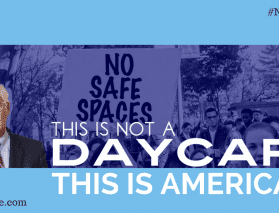“I’ll be bloodied and you’ll be bloodied, but at least you’ll know not to bully me again.” ~ Jay Rehak, Chicago teacher Source: Chicago Tribune
Much fuss is being made about the need for teachers in classrooms in Chicago as they strike today, creating chaos city-wide. But with teachers who make comments like the one above, I’m thinking the students may be better off outside of their classrooms.
I expect such immaturity from students — elementary students, that is — but not from teachers.
Clearly the teachers are passionate about their cause. But such scenes always cause me to think — as an educator — why are you teaching or serving on a school board? Is it a career for you or a calling? A career focuses on me. A calling motivates me to act for we.
The fact that Chicago teachers are either the highest paid or the second-highest paid public school teachers in the nation might give me a clue as to how they perceive it. The fact that they turned down a 4% annual raise for the next four years — while we suffer through the longest sustained bout of unemployment in this country since the Great Depression also might betray their viewpoint.
I’m not saying the teachers do or do not have some level of legitimate grievance. Key graphs from the Chicago Tribune:
Striking for the first time in 25 years, Chicago’s teachers set up picket lines this morning after talks with public school officials ended over the weekend without resolution.
“Rahm says cut back, we say fight back,” picketers dressed in red T-shirts chanted this morning outside Chicago Public Schools headquarters.
Chicago Teachers Union President Karen Lewis announced late Sunday night that weekend talks had failed to resolve all the union’s issues. “We have failed to reach an agreement that will prevent a labor strike,” she said. “No CTU members will be inside of our schools Monday.”
After an all-day negotiating session Sunday, school board President David Vitale told reporters the district had changed its proposal 20 times over the course of talks and didn’t have much more to offer.
“This is about as much as we can do,” Vitale said. “There is only so much money in the system.”
The district said it offered teachers a 16 percent pay raise over four years and a host of benefit proposals.
“This is not a small commitment we’re handing out at a time when our fiscal situation is really challenged,” Vitale said.
Lewis said the two sides are close on teacher compensation but the union has serious concerns about the cost of health benefits, the makeup of the teacher evaluation system and job security.
But frankly, most of the claims on both sides only make sense if you buy into the broken education model being used in Chicago and around most of the country in which we pour money into the big business of government schools effectively controlled by union bosses and political bureaucracies. Note the absence of the parental voice in that process. Government schools end up being no different than most other government programs — expensive, wasteful, and inviting corruption.
What is the answer?
So what is the answer to this Chicago teacher’s strike? Let’s start with what isn’t the answer.
1. More time is not the answer. One key sticking point in negotiations seems to be Mayor Emmanuel’s insistence on longer school days. The teachers want to be paid more for being required to relinquish more of their lives. Not sure who will be paying the children for their time — but I digress.
I’ll paraphrase Mark Twain and say insanity is doing more of the same things and expecting different results. Schools don’t need to do more of what they already do. Much of what they do now isn’t working all that well. They need to do less and focus more. As I recently heard a leader friend say, “We must narrow in order to broaden.” Counter-intuitive, but true. When our schools led the world, we covered fewer learning areas but at greater depth. Maybe we should shorten the school day and force schools to choose what’s really important to parents.
2. More money is not the answer. I’ve seen this truth first-hand for many years as a private school principal. Most private schools function with the public misperception that they have more resources than the public system. In fact, in the overwhelming number of cases, the opposite is true. Often the public system has 2 to 3 times more money to spend per student. Of course, it usually comes back from the federal government with strings attached that tie the hands of local leaders. Yet private schools must and do produce superior results with a fraction of the money.
They do it primarily for two reasons:
- Because they function in a competitive and open market, they can only afford to keep people who actually care about the kids. Those teachers and administrators are willing to accept the reality that they won’t get rich fulfilling their calling.
- Because they usually don’t have to deal with union bosses or bureaucratic baggage, they can be more flexible and creative to get the learning job done. Think of the difference in maneuverability between a speedboat and an aircraft carrier and you’ll get the idea.
In the absence of unions with broader agendas, teachers and administrators in most private settings have to deliver an excellent education for students and a favorable relationship with parents — or see who else is hiring. And what’s wrong with that? Don’t children deserve the best teachers who remain committed to their best?
3. Better leadership is the answer. True leadership sacrifices itself for the greater good of the followers. Legendary leadership voice John Maxwell calls it the Law of Sacrifice: You have to give up to go up. Jesus said that you must lose your life to gain it.
It’s often been said that people don’t care how much you know until they know how much you care. I wonder how much students in Chicago today care about how much their teachers know?
What’s needed are leaders in the city administration, union leaders, and teachers who are willing to put first things first — and I don’t mean themselves — to seek win-win solutions that make for better student learning.
Hint: The answer is not less short-term pain but more. Growth always requires short-term discomfort. But not as much as the alternative will demand.
Just ask the thousands of unsupervised kids on the streets today in Chicago.















